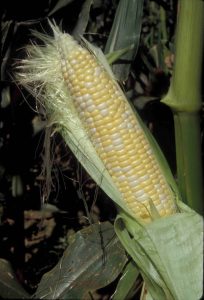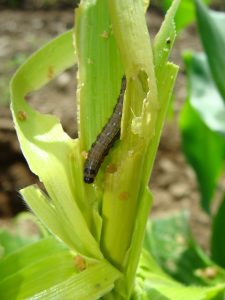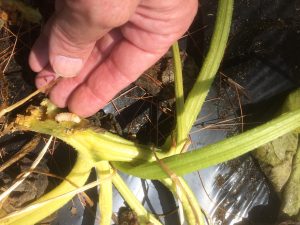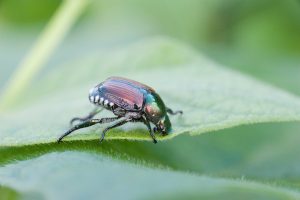Sweet Corn IPM Newsletter No. 3 – July 26, 2019

Sweet Corn IPM Newsletter No. 3 – July 26, 2019
Click on photos to enlarge.
FALL ARMYWORM NUMBERS INCREASE; THREATEN SILKING CORN
Moderate Corn Earworm Pressure at Most Locations
Highmoor Farm Field Day
For Fruit and Vegetable Growers
Monmouth, Maine
Wednesday, July 31 from 2:30 p.m. to 7:30 p.m.
Preregister now!
SITUATION
Continued good weather for corn development means harvest is not far away in early fields. Fall armyworm moth counts and, to a lesser extent, corn earworm counts have risen this week, increasing the risk to any silking corn. Fall armyworm feeding damage on young corn is also expected to become prevalent in the near future.
European corn borer: Feeding injury was over the 15% control threshold for pre-tassel corn in Biddeford, one Cape Elizabeth site, and Sabattus. European corn borer moth counts were over the spray threshold for silking corn this week at one Cape Elizabeth site, but this field was also on a recommended 4-day spray interval for corn earworm, which should also provide protection against corn borer.

Corn earworm: Moth catches are increasing, although still spotty around the state; however the availability of silking corn is also increasing, so more locations will need to protect their fields. A six-day spray interval for silking corn was recommended in Biddeford, New Gloucester, Garland and Levant. A five-day spray interval was recommended for silking fields in Auburn and one Cape Elizabeth site. A 4-day spray schedule was recommended at one Cape Elizabeth site.
Fall armyworm: Moth counts were higher at most locations this week. Sprays to protect silking corn against fall armyworm were recommended in Dayton and Wells. Other sites including Auburn, Cape Elizabeth, Lewiston, New Gloucester, and one Wells site were also over the three-moth threshold for silking corn; but these were already under a spray interval for corn earworm and should be protected by that. Larval feeding damage to young corn has been very light, but we expect to see damaging increase significantly soon.
Squash vine borer moths were caught in pheromone traps in Wells, Biddeford, New Gloucester and Oxford this week. Counts were above the spray threshold of 5 moths in Biddeford, New Gloucester and Oxford. Growers should be on the lookout for vine borer damage, and protect plants if moths or damage are seen.
- Squash Vine Borer Larva; photo by David Handley
- Japanese Beetle, photo by Edwin Remsberg, USDA
Japanese beetles are now appearing in southern and mid-state areas. These insects often find their way into cornfields and feed on the silks of developing ears, causing poor tip fill. Sprays for corn earworm (except Bt’s) will often control Japanese beetle as well.

University of Maine Highmoor Farm Field Day
Wednesday, July 31, 2019, 2:30 PM to 7:30 PM
Highmoor Farm, Monmouth, Maine
Registration fee is $30.00 (includes dinner).
The field day will include tours of current research projects in tree fruit and in vegetables and berries, followed by a barbeque dinner. Preregistration is strongly encouraged. Register online or contact Pam St. Peter at pamela.stpeter@maine.edu or 207.933.2100 for registration information. If you need a reasonable accommodation, please contact Pam St. Peter at 207.933.2100. (Registration is closed)
Sincerely,
David T. Handley
Vegetable and Small Fruit Specialist
Highmoor Farm UMaine Extension Diagnostic
P.O. Box 179 Research Lab, Pest Mgmt. Unit
52 U.S. Route 202 17 Godfrey Drive
Monmouth, ME 04259 Orono, ME 04473
207.933.2100 1.800.287.0279
Sweet Corn IPM Weekly Scouting Summary
| Location | CEW Moths |
ECB Moths |
FAW Moths |
%Feeding Damage |
Recommendations / Comments |
|---|---|---|---|---|---|
| Auburn | 4 | 0 | 8 | 5% | 5-day spray interval for all silking corn |
| Biddeford | 3 | 0 | 1 | 18% | 6-day spray interval for silking corn, ECB on pre-tassel |
| Bowdoinham | 0 | 0 | 2 | 2% | No spray recommended |
| Cape Elizabeth I | 5 | 3 | 5 | 0% | 5-day spray interval for silking corn, ECB on pre-tassel |
| Cape Elizabeth II | 13 | 10 | 4 | 17% | 4-day spray interval for silking corn, ECB on pre-tassel |
| Charleston | 0 | 1 | 0 | 0% | No spray recommended |
| Garland | 3 | 1 | 0 | 1% | 6-day spray interval for all silking corn |
| Dayton I | 0 | 0 | 4 | 0% | One spray for FAW on silking corn |
| Dayton II | 0 | 2 | 3 | 1% | One spray for FAW on silking corn |
| Farmington | 0 | 0 | 0 | 0% | No spray recommended |
| Lewiston | 12 | 0 | 15 | 1% | 4-day spray interval for all silking corn |
| Levant | 3 | 4 | 1 | 3% | 6-day spray interval for all silking corn |
| New Gloucester | 2 | 0 | 6 | – | 6-day spray interval for all silking corn |
| No. Berwick | 0 | 4 | 0 | 0% | No spray recommended |
| Oxford | 0 | 0 | 2 | 0% | No spray recommended |
| Palmyra | 0 | 0 | 0 | 0% | No spray recommended |
| Poland Spring | 1 | 3 | 0 | 4% | No spray recommended |
| Sabattus | 1 | 3 | 0 | 19% | One spray for ECB feeding |
| Wells I | 0 | 2 | 0 | 3% | No spray recommended |
| Wells II | 0 | 1 | 6 | 3% | One spray for FAW on silking corn |
CEW: Corn earworm (Only fresh silking corn should be sprayed for this insect.)
ECB: European corn borer
FAW: Fall armyworm
Corn Earworm Spray Thresholds for Pheromone Traps
| Moths caught per week | Moths caught per night | Spray interval |
|---|---|---|
| 0.0 to 1.4 | 0.0 to 0.2 | No spray |
| 1.5 to 3.5 | 0.3 to 0.5 | Spray every 6 days |
| 3.6 to 7.0 | 0.6 to 1.0 | Spray every 5 days |
| 7.1 to 91 | 1.1 to 13.0 | Spray every 4 days |
| More than 91 | More than 13 | Spray every 3 days |
Thresholds apply only to corn with exposed fresh silk. Lengthen spray intervals by one day if maximum daily temperature is less than 80°F.
European Corn Borer Thresholds
Whorl stage: 30% or more of plants scouted show injury.
Pre-tassel-silk: 15% or more of plants scouted show injury.
Silk: 5 or more moths caught in pheromone traps in one week.
IPM Web Pages:
UMaine Cooperative Extension Integrated Pest Management
Penn State Pest Watch – Sweet Corn
UMass Amherst Integrated Pest Management
Where brand names or company names are used, it is for the reader’s information. No endorsement is implied nor is any discrimination intended against other products with similar ingredients. Always consult product labels for rates, application instructions and safety precautions. Users of these products assume all associated risks.
The University of Maine is an equal opportunity/affirmative action institution.


